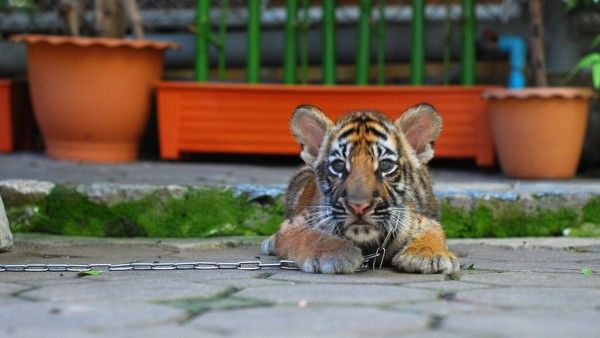Today, fewer than 4,000 tigers remain in the wild, but as many as 8,000 are still being held captive across China, Laos, Thailand, and Vietnam.
Some of these tiger facilities across Asia are licensed by national governments and are open to the public. Many are promoted and marketed as zoos, conservation centers, or tourist entertainment venues. But most are basically factory farms, speed-breeding tigers like livestock to satisfy mainly Chinese and Vietnamese demand for their body parts. The rest are small-scale basement or backyard breeding mills existing outside the law.
According to The National Geographic,the tiger breeding industry is still rampant throughout Asia and it’s fueling the illegal wildlife trade. Captive-bred tigers slip into the illegal international trade and feed a growing demand for tiger products, primarily in China. Especially popular are tiger pelts, which are used in luxury home decor, and their bones, an ingredient in expensive tiger-bone wine. This high-end market places a huge price tag on the head of every remaining tiger, and the wild populations are being decimated.

Image: World Animal Protection
The commercial international trade in tigers and their parts has been banned since 1987 after a vote by CITES, an international treaty regulating the wildlife trade. In 2007, the CITES parties approved a measure stating that tigers shouldn’t be bred for trade either. Yet captive tigers are increasingly showing up alongside wild tigers on the illegal wildlife market.
Captive tiger breeding is a huge problem throughout Asia, but particularly in Thailand. These animals are being bred to fuel the cruel wildlife tourism and traditional medicine industries. At wildlife tourist attractions in Thailand, the baby tigers spend their lives being used and exploited as photo props for tourist selfies. When they are no longer cute or become too difficult to control, the tigers are then killed to meet the demand for traditional Asian medicine.
World Animal Protection is now urging Thailand authorities to enforce a ban on captive tiger breeding by 2020. The hope is that without captive breeding, fewer tigers will become victims of this horrific cycle of exploitation and abuse. Tigers are wildlife and all wild animals belong in the wild, but unfortunately the tiger cubs bred in captivity will never get to live in their natural environment.

Image: World Animal Protection
Just like all animals suffering in the tourism industry, captive-bred cubs at tourist attractions endure immense cruelty. They’re kept in barren enclosures, with limited access to fresh food and water. Baby animals in tourism are cruelly trained, chained, and forced to frequently interact with visitors. They are forced to take selfies with tourists all day long, while loud noises and constant camera flashes surround them.
An official ban on captive tiger breeding from Thailand authorities would be a significant step in the right direction, since captive breeding continues to fuel the abusive tourism industry. Any captive animal that is being forced to perform tricks or take selfies with tourists is suffering immense abuse behind-the-scenes. And when they are not cute anymore, their future becomes even more grim. Ongoing investigations are still finding that many tigers in tourism end up killed for their body parts, used in traditional medicine and as home decorations.







